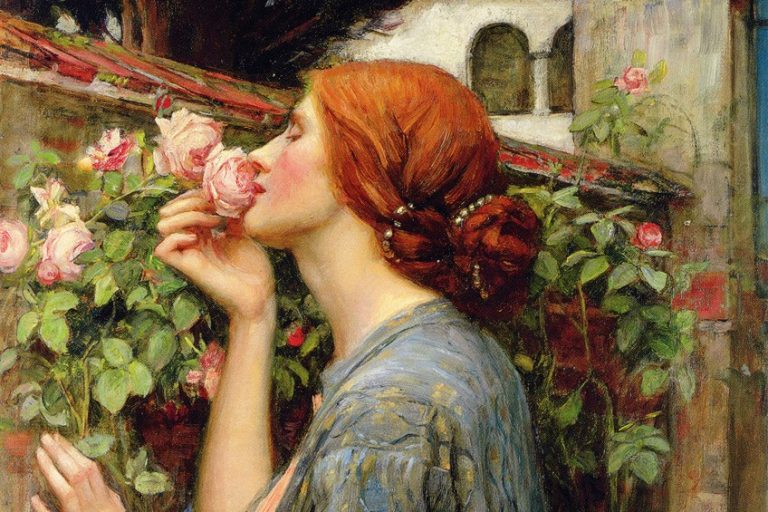“The Card Players” by Paul Cézanne – The Card Players Analysis
Paul Cézanne’s The Card Players (c. 1890 – 1892) is just one of his most iconic paintings depicting card players from his series of five. This article will take a closer look at this painting and what makes it so different from the regular genre paintings of card players.
Artist Abstract: Who Was Paul Cézanne?
Paul Cézanne was born in the city of Aix-en-Provence in France, his date of birth was on January 19, 1839, and he died on October 22, 1906. While he lived in the countryside, he also lived in Paris for some time where he was exposed to the city’s art life and the emerging styles of the time that included those of Édouard Manet, Claude Monet, Camille Pissarro, and more. He mainly painted within the Landscape, Still Life, and Portrait genres, often depicting items like fruits and human figures. He was also known to study classical art in the Louvre and found his own style separate from that of the Impressionists, which made him one of the “founding fathers” of Post-Impressionism. Some of his artworks include The Basket of Apples (1895), The Bathers (1898 – 1905), and Mont Sainte-Victoire (1905).

The Card Players (c. 1890 – 1892) by Paul Cézanne in Context
The following The Card Players analysis will discuss the series of five paintings by Paul Cézanne and its socio-historical context, which will look at why he painted them and what inspired him. It will also discuss a formal analysis with a focus on the version that is held at the Metropolitan Museum of Art in New York City.
| Artist | Paul Cézanne (1839 – 1906) |
| Date Painted | c. 1890 – 1892 |
| Medium | Oil on canvas |
| Genre | Genre painting |
| Period / Movement | Post-Impressionism |
| Dimensions (cm) | 65.4 x 81.9 |
| Series / Versions | Part of five paintings of card players |
| Where Is It Housed? | Metropolitan Museum of Art, New York City, United States |
| What It Is Worth | Reportedly sold for $85,000 to Stephen C. Clark in 1931 |
Contextual Analysis: A Brief Socio-Historical Overview
The Card Players by Paul Cézanne was created during the 1890s, and as mentioned above, consists of five paintings, each varying in size. There has also been scholarly debate and uncertainty around which painting the artist created first.
Without a specific focus on the ordering of the paintings, the larger canvases depicting four and five figures are namely The Card Players (c. 1890 – 1892) at the Metropolitan Museum of Art (MET) in New York City, and The Card Players (c. 1890 – 1892), which is at The Barnes Foundation in Philadelphia, Pennsylvania.
The other three smaller canvases depicting only two figures, which may have been the last three paintings, are namely The Card Players (c. 1892 – 1895) at the Courtauld Gallery in London, The Card Players (c. 1894 – 1895) at the Musée d’Orsay in Paris, and The Card Players (c. 1892 – 1893). The latter is part of a private collection, which reportedly sold for around $250 million to the Royal Family of Qatar.
Inspiration: Why Did Cézanne Paint The Card Players?
The subject matter of card players in art is not new, in fact, it has often been depicted by artists from the 1600s as genre paintings. Paul Cézanne depicting card players of the three Le Nain brothers, namely Antoine, Louis, and Mathieu, when it was exhibited in one of the art galleries in Aix-en-Provence.
Some famous examples include the painting by Mathieu Le Nain The Card Players (c. 1635 – 1640) and The Little Card Players (c. 1635 – 1640) reportedly by Antoine Le Nain. However, this subject matter is also in other paintings like the one often referred to as The Cardsharps (c. 1594) by the Baroque artist Caravaggio and The Cheat with the Ace of Diamonds (1635), also by a Baroque artist Georges de la Tour.
Who Are the Card Players?
Paul Cézanne reportedly created several preparatory “studies” of his figures before he painted them in The Card Players compositions. He also reportedly painted local peasants, who modeled for him, at what was his family farmhouse the Jas de Bouffan. Some of the peasants’ names were also noted, namely, Paulin Paulet, who was reportedly a gardener who worked on the Cézanne family farm, he was believed to be a model in several of The Card Players paintings.
The other model was another farmworker known as “le père Alexandre” who interestingly also modeled for some of Cézanne’s other paintings like Man with a Pipe (c. 1892 – 1896), among several others.
Formal Analysis: A Brief Compositional Overview
The formal The Card Players analysis will describe one of the paintings in more detail, focusing the lens on how Paul Cézanne arranged his subject matter and how he applied colors and textures, as well as how lines, shapes, form, and space compose it, all of which are the elements of art. It is important to note that while there are five paintings of this subject matter by Paul Cézanne, we will discuss the painting from around 1890 to 1892, held at the Metropolitan Museum of Art.

Subject Matter: Visual Description
In The Card Players (c. 1890 – 1892) Paul Cézanne depicts four men, three sitting at a small square table playing a game of cards and one standing to the left in the background watching the card game unfold before him. To the right background are four smoking pipes hanging on the wall and a curtain to the edge of the composition.
All four men are wearing hats that appear to be bowler or cowboy hats, and they appear to wear jackets over their clothing. The three men at the table are looking down at the cards in front of them. The man sitting in the middle is holding a set of cards while it appears that the two men on the sides of the table are not holding cards, could they have placed them on the table?
The man standing near the wall in the background has his arms folded at his chest with a white pipe in his mouth.
The other three men do not have pipes in their mouths, but there is another white pipe lying on the table, which suggests that one of the men is smoking too. The composition also appears calm in its mood, the men are not overly animated and are reserved in their composures, concentrating on the card game. In Paul Cézanne’s other versions, the card players also appear cool and calm.
For example, in The Card Players at the Barnes Foundation, there are five figures in the composition, including a figure standing near the wall observing the game like in the abovementioned version, additionally, there is also a young child to the right in the background.
In another example, The Card Players from the Courtauld Gallery depicts two men sitting at a table, at somewhat an angle, holding a set of cards and seemingly deep in thought about what card they will each be choosing next. The man to the left is smoking a pipe and both are also wearing hats.
The other two versions from the Musée d’Orsay and private collection also depict two men sitting at a table, but with subtle changes to the subject matter, for example, a wine bottle is noticeable on the table.
Color
There are various earthy colors in The Card Players by Paul Cézanne, from the browns and creams of two of the men seated at the table, which is also juxtaposed by the deeper blue of the jacket of the man sitting on the right. The man standing near the wall is also wearing a deeper blue jacket with what appears to be a red cravat, which creates a subtle contrast against the more neutral hues.
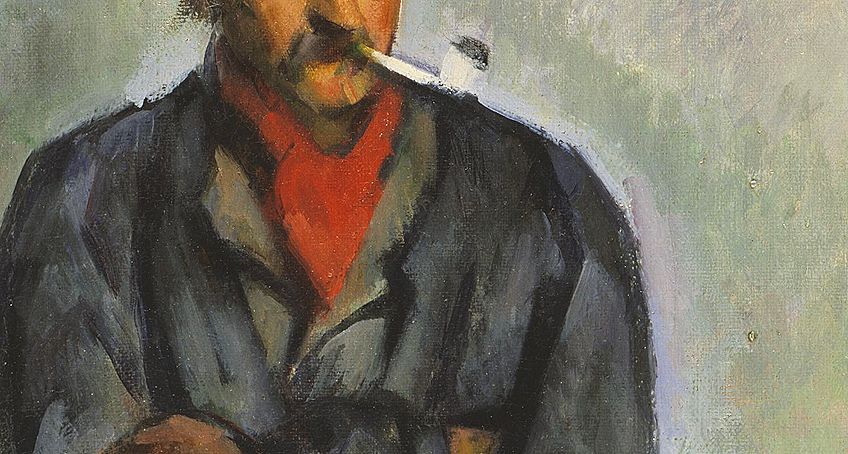
The wall is a variety of colors like lighter greens, blues, and what appears to be pinks and grays, which is contrasted by the deeper yellow or bronze-gold of the curtain to the right. The light blue of the table seemingly echoes the color of the wall. Furthermore, the blue, red, and white colors are also echoed on the card lying in the center of the table.
Depth is created by shading, notable in the folds of the men’s jackets and the folds of the curtain.
Texture
Paul Cézanne’s brushstrokes are seemingly tangible on the canvas and appear thickly applied in areas, furthermore, the brushstrokes appear haphazardly applied, some are short and choppy while others are longer and more evenly and smoothly applied.
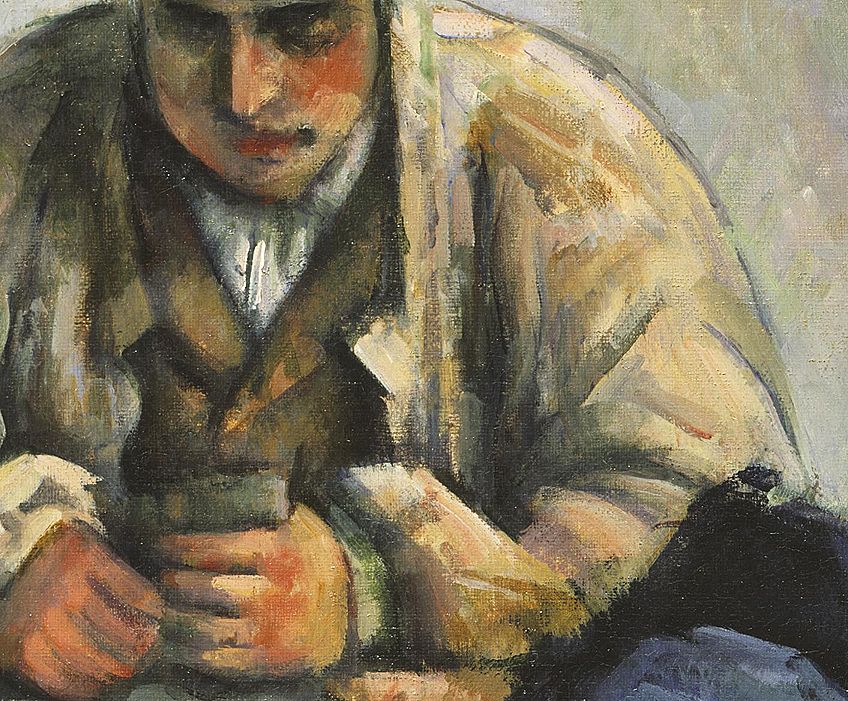
Shape and Form
Paul Cézanne’s The Card Players depicts naturalistic or organic forms, in other words, his subject matter is figurative, and objects associated with the real world so to say – human figures, a table, a curtain, hats, smoking pipes, and chairs. An interesting fact about Cézanne’s art processes, and something he was well known for, were his theories around the geometricity of compositions.
He is often quoted as stating to, “treat nature by means of the cylinder, the sphere, the cone”, in other words, the basic shapes that create the underlying structures of form, which is evident in many of his still life paintings.

Line
There is a variety of lines in The Card Players by Paul Cézanne, many are created by the visible appearance of the brushstrokes, for example, the folds on the men’s jackets, specifically the pronounced patterned lines of the man sitting to the right, the folds on the curtains to the right, as well as the diagonal lines on the curtains, which create a pattern.
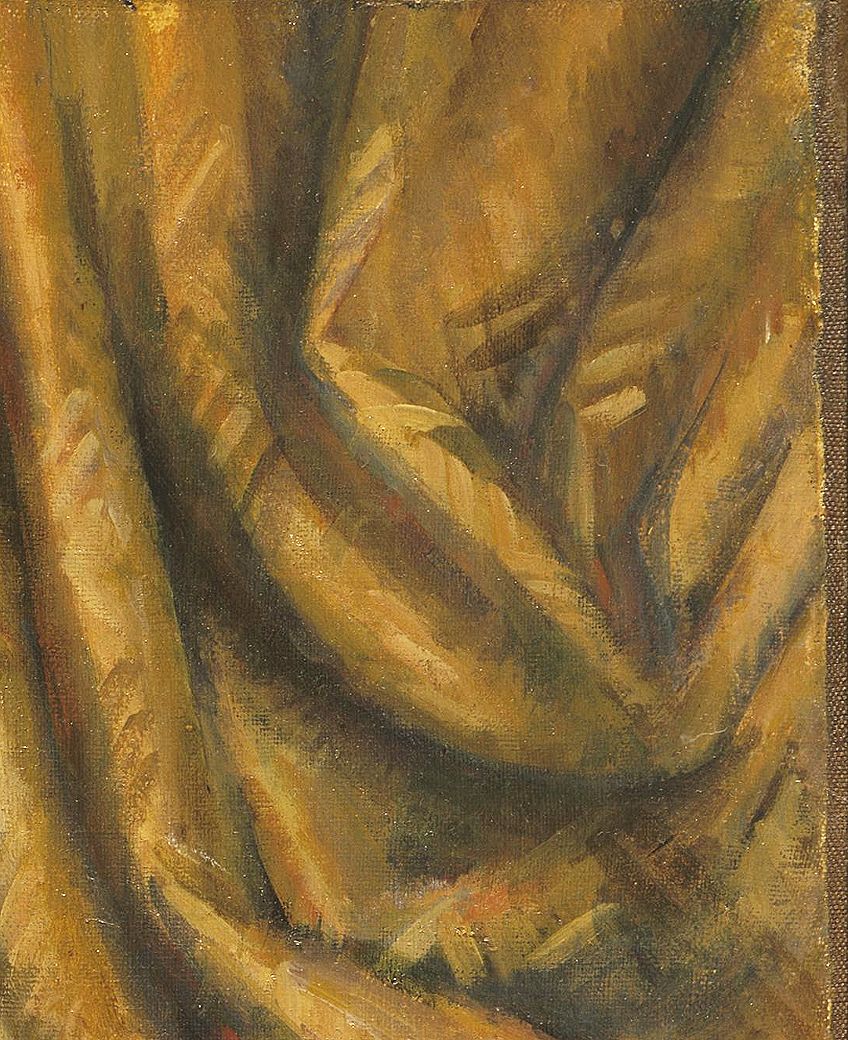
Space
Paul Cézanne’s spatial composition in The Card Players depicts the scene as if we, the viewers, are watching the card game from a short distance away, and seemingly more angled from the right. There is a sense of depth created by how Paul Cézanne placed his figures, for example, the two figures sitting at either end of the table create a layering effect for the figure sitting at the middle of the table. This effect is further created by the figure in the background.
The lower portion of the composition is also cut off and we cannot fully view the men’s or the table’s feet.
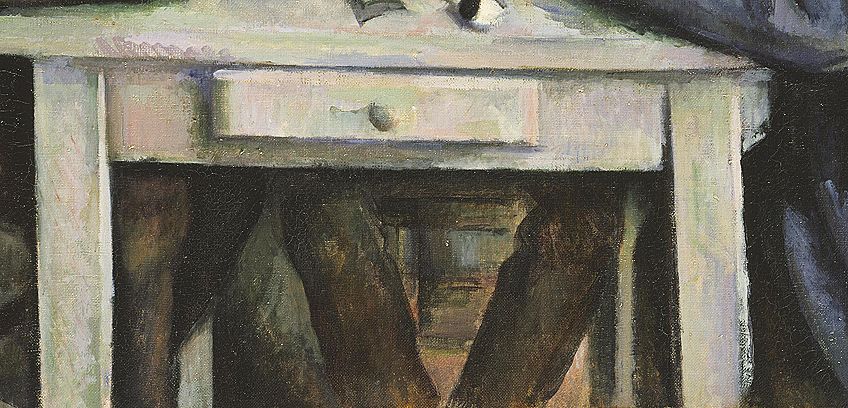
The background space also appears ambiguous in its spatial depth, made evident by the man by the wall; it is not clear if he is leaning against the wall or standing with some space between himself and the wall. However, the floor and skirting are visible to the left, which invites us to determine the man’s distance from us.
Cézanne Upping the Ante
What set The Card Players by Paul Cézanne apart from other card player paintings are the cool, calm, and collected composures of his players, compared to representations expected from such activities, commonly associated with brawling behavior, furthermore, as it is described by many others, Cézanne was believed to have painted this subject matter to explore it as a still life.
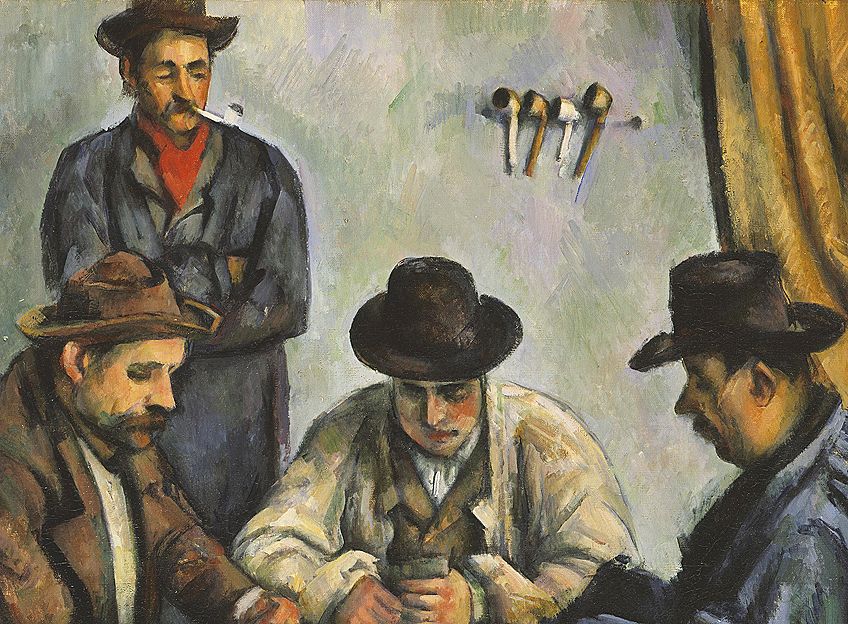
This article discussed The Card Players analysis, specifically the version held at the Metropolitan Museum of Art in New York City, which depicts four card players. It is just one example of many of Cézanne’s artistic styles that made him one of the pioneers of Post-Impressionism, not only playing with the nuances of colors, shapes, textures, and space but applying them with acuity and sensibility that paved the way for other modern art movements like Cubism.
Take a look at The Card Players painting webstory here!
Frequently Asked Questions
Who Painted The Card Players?
The Card Players (c. 1890-1895) was painted by Paul Cézanne, one of the leading originators of the French Post-Impressionist art movement. He painted five versions of the theme around card players, all of which are housed at different museums throughout the world, including private collections.
How Many The Card Players Paintings Are There?
There are five The Card Players (c. 1890 – 1895) paintings by Paul Cézanne, namely: The Card Players (c. 1890-1892), held at The Barnes Foundation in Philadelphia, Pennsylvania; The Card Players (c. 1890-1892), held at the Metropolitan Museum of Art in New York City; The Card Players (c. 1892-1895), held at the Courtauld Institute of Art in London; The Card Players (c. 1892-1893), which is in a private collection; and The Card Players (c. 1894-1895), held at the Musée d’Orsay in Paris.
Who Are the Men in Paul Cézanne’s The Card Players?
Paul Cézanne reportedly painted his card players from men that modeled for him, who were peasant workers from the artist’s family home. Two of the men have been named le père Alexandre and Paulin Paulet.
Alicia du Plessis is a multidisciplinary writer. She completed her Bachelor of Arts degree, majoring in Art History and Classical Civilization, as well as two Honors, namely, in Art History and Education and Development, at the University of KwaZulu-Natal, South Africa. For her main Honors project in Art History, she explored perceptions of the San Bushmen’s identity and the concept of the “Other”. She has also looked at the use of photography in art and how it has been used to portray people’s lives.
Alicia’s other areas of interest in Art History include the process of writing about Art History and how to analyze paintings. Some of her favorite art movements include Impressionism and German Expressionism. She is yet to complete her Masters in Art History (she would like to do this abroad in Europe) having given it some time to first develop more professional experience with the interest to one day lecture it too.
Alicia has been working for artincontext.com since 2021 as an author and art history expert. She has specialized in painting analysis and is covering most of our painting analysis.
Learn more about Alicia du Plessis and the Art in Context Team.
Cite this Article
Alicia, du Plessis, ““The Card Players” by Paul Cézanne – The Card Players Analysis.” Art in Context. January 25, 2023. URL: https://artincontext.org/the-card-players-by-paul-cezanne/
du Plessis, A. (2023, 25 January). “The Card Players” by Paul Cézanne – The Card Players Analysis. Art in Context. https://artincontext.org/the-card-players-by-paul-cezanne/
du Plessis, Alicia. ““The Card Players” by Paul Cézanne – The Card Players Analysis.” Art in Context, January 25, 2023. https://artincontext.org/the-card-players-by-paul-cezanne/.





